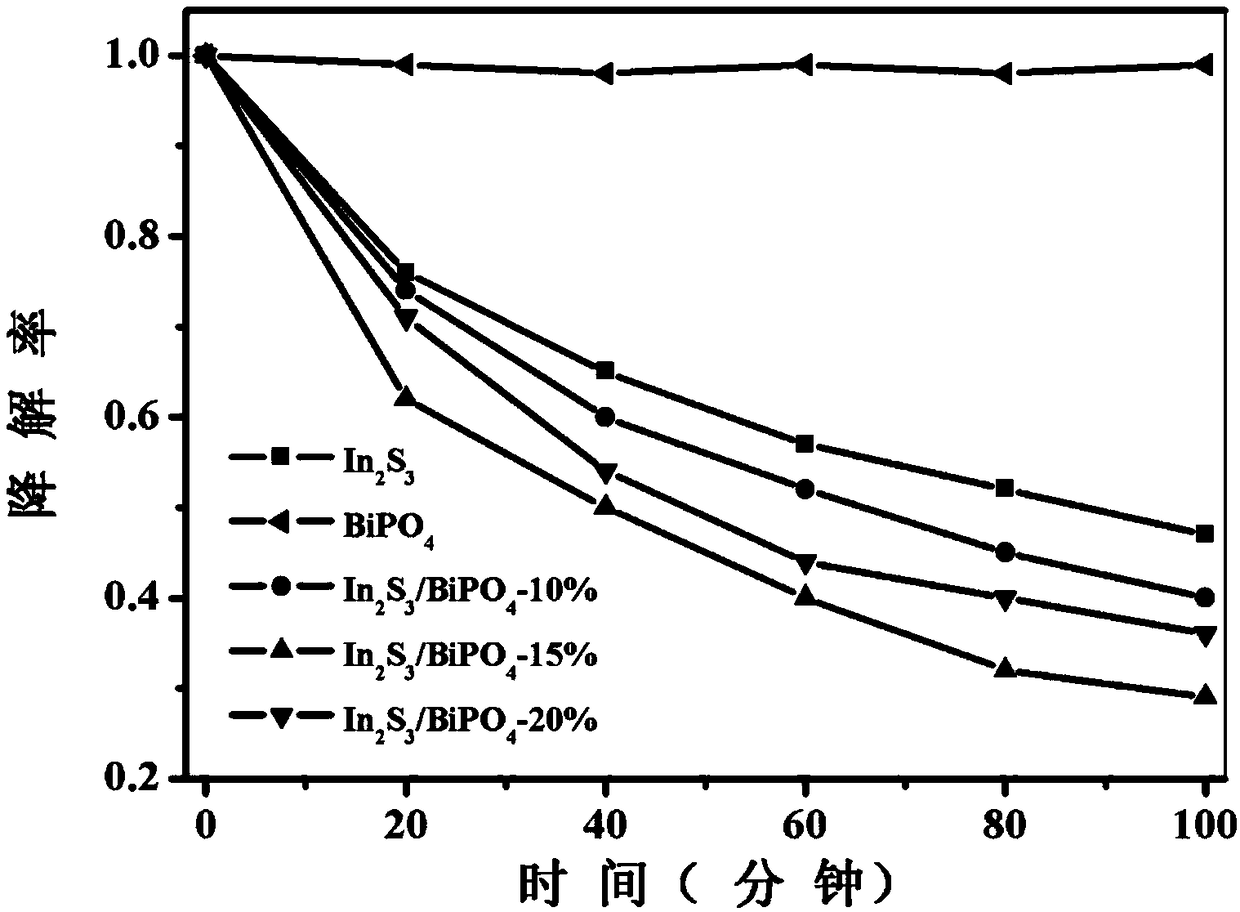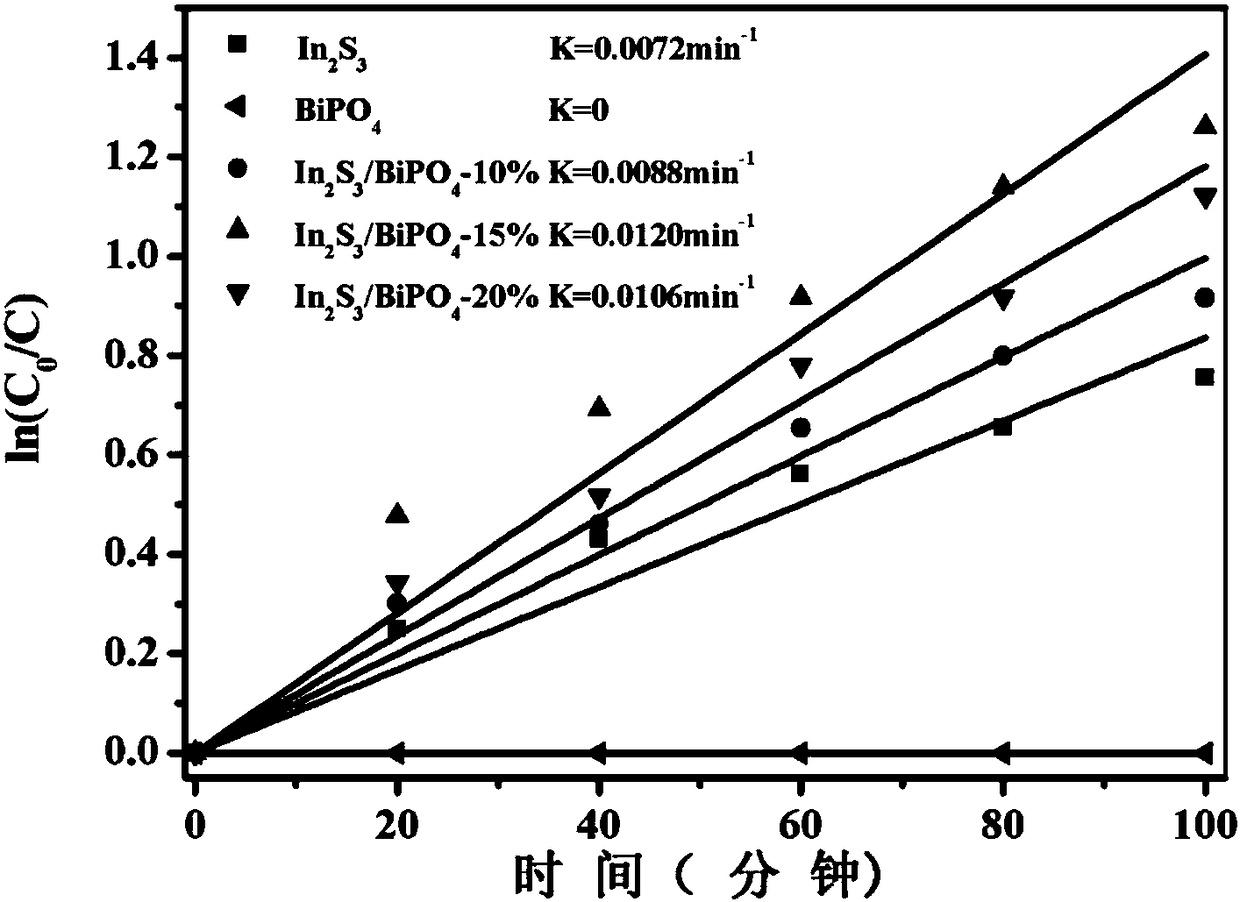Preparation method and applications of In2S3/BiPO4 heterojunction photocatalyst
A photocatalyst and heterojunction technology, applied in physical/chemical process catalysts, chemical instruments and methods, chemical/physical processes, etc., can solve problems such as excessive band gap, low quantum efficiency, and reduced photocatalytic activity
- Summary
- Abstract
- Description
- Claims
- Application Information
AI Technical Summary
Problems solved by technology
Method used
Image
Examples
Embodiment 1
[0029] (1) In 2 S 3 preparation of
[0030] 1 mmol InCl 3 and 2 mmol of TAA were dissolved in 40 mL of deionized water and stirred until clear, and the pH was adjusted to 12 with NaOH. The resulting mixed liquid was transferred to a 70 mL stainless steel autoclave, sealed and kept at 120° C. for 12 hours, and then cooled to room temperature. The obtained product was collected by centrifugation, washed several times with absolute ethanol and deionized water, and then dried at 60°C for 12 hours.
[0031] (2) BiPO 4 preparation of
[0032] 1mmol of Bi(NO 3 ) 3 ·5H 2 O was dissolved in 2.5 mL of ethylene glycol and stirred for 30 min to prepare a clear solution. 1.5mmol of NH 4 h 2 PO 4 Dissolve in 30mL of deionized water and slowly add to the above solution. The resulting white suspension was further stirred at room temperature for 30 minutes to achieve homogeneity. The suspension was centrifuged and washed several times with deionized water and absolute ethanol to ...
Embodiment 2
[0039] (1) In 2 S 3 preparation of
[0040] 1 mmol InCl 3 and 2 mmol of TAA were dissolved in 40 mL of deionized water and stirred until clear, and the pH was adjusted to 13 with NaOH. The resulting mixed liquid was transferred to a 70 ml stainless steel autoclave, sealed and kept at 120° C. for 12 hours, and then cooled to room temperature. The obtained product was collected by centrifugation, washed several times with absolute ethanol and deionized water, and then dried at 60°C for 12 hours.
[0041] (2) BiPO 4 preparation of
[0042] 1mmol of Bi(NO 3 ) 3 ·5H 2 O was dissolved in 2.5 mL of ethylene glycol and stirred for 30 min to prepare a clear solution. 1.5mmol of NH 4 h 2 PO 4 Dissolve in 30mL of deionized water and slowly add to the above solution. The resulting white suspension was further stirred at room temperature for 30 minutes to achieve homogeneity. The suspension was centrifuged and washed several times with deionized water and absolute ethanol to ...
Embodiment 3
[0049] (1) In 2 S 3 preparation of
[0050] c. 1 mmol of InCl 3 and 2 mmol of TAA were dissolved in 40 ml of deionized water and stirred until clear, and the pH was adjusted to 14 with NaOH. The resulting mixed liquid was transferred to a 70 ml stainless steel autoclave, sealed and kept at 120° C. for 12 hours, and then cooled to room temperature. The obtained product was collected by centrifugation, washed several times with absolute ethanol and deionized water, and then dried at 60°C for 12 hours.
[0051] (2) BiPO 4 preparation of
[0052] c. Add 1mmol of Bi(NO 3 ) 3 ·5H 2 O was dissolved in 2.5 mL of ethylene glycol and stirred for 30 min to prepare a clear solution. 1.5mmol of NH 4 h 2 PO 4 Dissolve in 30ml of deionized water and slowly add to the above solution. The resulting white suspension was further stirred at room temperature for 30 minutes to achieve homogeneity. The suspension was centrifuged and washed several times with deionized water and absolut...
PUM
 Login to View More
Login to View More Abstract
Description
Claims
Application Information
 Login to View More
Login to View More - R&D
- Intellectual Property
- Life Sciences
- Materials
- Tech Scout
- Unparalleled Data Quality
- Higher Quality Content
- 60% Fewer Hallucinations
Browse by: Latest US Patents, China's latest patents, Technical Efficacy Thesaurus, Application Domain, Technology Topic, Popular Technical Reports.
© 2025 PatSnap. All rights reserved.Legal|Privacy policy|Modern Slavery Act Transparency Statement|Sitemap|About US| Contact US: help@patsnap.com



